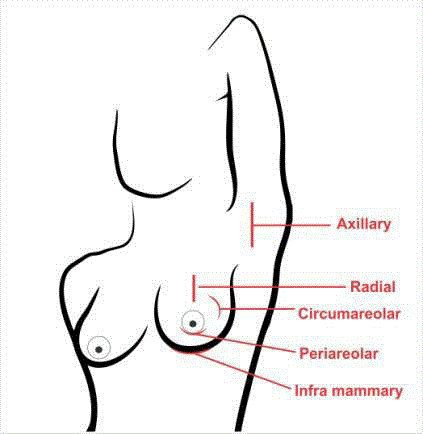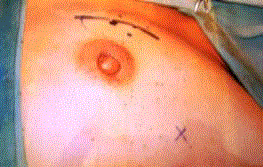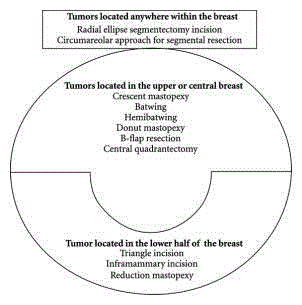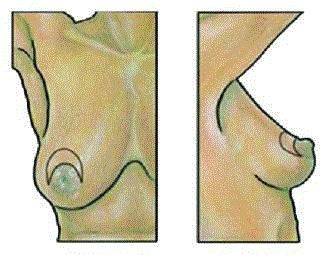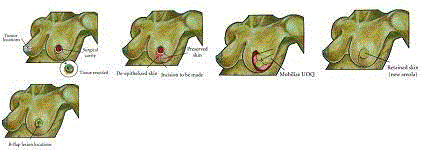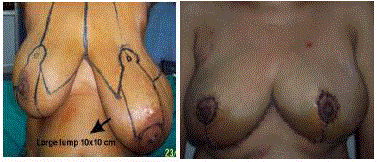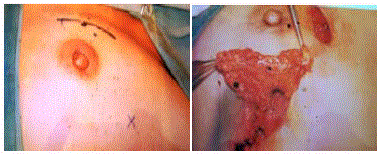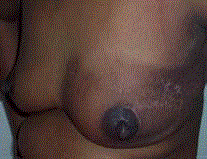Case Report
Breast Reconstruction after Lumpectomy
Anshuman Manaswi*
Consultant Plastic Surgeon, Bombay Hospital and Medical Research Centre Mumbai, India
*Corresponding author: Anshuman Manaswi, Consultant Plastic Surgeon, Bombay Hospital and Medical Research Centre, La Transformation'e, Flat No: 202, Saqib CHSL, Above Tavaa Restaurant, Turner Road, Bandra west, Mumbai, Maharashtra
Published: 27 Sep, 2017
Cite this article as: Manaswi A. Breast Reconstruction after
Lumpectomy. Clin Surg. 2017; 2: 1633.
Abstract
Apart from function, beast is aesthetically and sexually a very important organ. Reconstruction of
breast after breast conservation surgery in cases of malignancy and after benign lumpectomy has to
be given due importance and the results are more than often rewarding.
The preoperative considerations, planning, motivation/demotivation, intraoperative techniques of
Oncoplastic surgeries and other methods of filling partial mastectomy defects are dealt in this article.
Whether simultaneous or delayed reconstruction is preferable is also elaborated. How and whether
quality of life is affected with reconstruction is a thought provoking issue and has been discussed.
Keywords: Lumpectomy; Breast conservation; Breast reconstructions; Oncoplastic techniques;
Pectoralis major flap; Reduction mammoplasty; Volume replacement; Volume displacement
Introduction
Breast, arguably one of the most important organs, both aesthetically and functionally, is most
dreaded when it comes to disease. So much so, that it became a super specialty subject much before
many other organs became one. Adding to our trouble surgically is the fact that there are two
breasts. As if one was not enough!
Breast reconstruction is an aesthetic procedure and it has to be borne in mind every single time
a reconstruction is attempted. Another factor to be borne in mind is the ‘feel’ of the tissue because
of its sexual - emotional component. How far just putting a flap for creating a mound which is
of different consistency and is insensate, actually satisfies the patient is a matter of debate [1-3].
Lumpectomy/Mastectomy with or without reconstructions have little bearing on the quality of life
of the patient but the Breast Conservation group has slight advantage over the Mastectomy group
[4]. The sexual activities in fact decreased in the breast reconstruction group [5]. In some studies the reconstruction group surprisingly had a less than expected benefit on body image and they felt
more likely that breast cancer had a negative impact on their sex lives. The fear of recurrence is a
parameter which is most important and seems to affect QOL assessment more than the choice of
surgery [6-8]. Kalaaji and Bruheim compared TRAM flap, lateral thoracodoral flap and implant
reconstruction and found that there were positive effects of reconstruction in physical, social and
psychological aspects and about 81% would be comfortable referring the reconstruction procedures
to others in similar condition. The results of TRAM was the best followed by LD flap and implant
[9]. The fact is that often we do a breast reconstruction without keeping all these objectives in
mind, for just creating a mound which resembles a breast. Options which are given to the patient,
which includes the option of not to reconstruct immediately, varies from surgeon to surgeon,
the healthcare limitations, manpower limitations etc. [13-16]. Recent studies show that delayed
reconstructions may be better from Oncology point of view, but delayed reconstructions have a
problem of low motivation from the patient’s point of view. But other studies have also pointed in
different direction regarding the quality of life in immediate vs. delayed reconstructions [10-12].
The compliance will definitely improve once we have better to offer in terms of consistency and
sensation of the breast and simpler procedures for reconstruction. It is time we start concentrating
on these important factors. Some flaps like TRAM and SGAP flap do give better breast like feel than
others like LD. The jury is not out as to which is better; reconstruction or not, and various other
factors like adjuvant chemotherapy, radiation therapy, age of the patient etc. determine how the
patient is going to decide about breast reconstruction [17]. All patients must be individualized and
taken into confidence and assessed in an unbiased way before deciding upon the reconstruction.
Although Total breast reconstructions have fancied the minds of Plastic surgeons, probably
because of the fascination for technical challenges involved, sadly the partial breast reconstructions
especially in the benign settings have been under performed. Why this happens is probably because
benign breast lumps are operated by General surgeons, Gynaecologists, Cancer surgeons, Breast surgeons and Plastic surgeons. Not all of these groups of surgeons are most aware about the cosmetic aspect and its implications. In
contrast to Head and Neck area where even a small defect hinders
functionally and aesthetically, in breast, since the functional defect is
less, the sexual- emotional factor takes the brunt.
Breast reconstruction to fill partial mastectomy defects or to fill
the lumpectomy defects requires simpler but precise techniques. It is
very rewarding to the surgeon as well as to the patient. Often it can be
made inconspicuous without leaving much stigma of a precious scar.
In the scenario that ‘Cancer’ word is more focused upon, we tend to
forget that excision of benign lesions also causes breast deformities
and a conscious effort must be made to keep this fact in mind.
Pre surgical planning
It is important to keep some points in mind before the surgery
1. Usually there is a size discrepancy between the two breasts and
it can be made to use to our benefit. For e.g. excision of a tumour in a
larger breast can modify the breast to match the other breast.
2. Photography of the breasts should be done always; from front,
sides and oblique views for objective comparison.
3. Whether the lumpectomy is being done for benign disease or
for a malignant disease.
4. Incision for primary excision should be planned in such a way
so as to make the scar least visible and if possible, reconstruction to be
done from the same incision.
5. Endoscopic resections if possible can hide the scars and
minimise the scars, especially in benign diseases.
6. Usually any defect more than 3 cm in diameter will leave
some deformity unless very deeply seated. The magnitude of the
problem can be understood by this fact that most of the malignant
lumpectomies and significant number of benign lumpectomies will
require some form of reconstruction.
Concepts for aesthetic reconstruction
1. To understand that Breast is a 3 dimensional structure which
has significant mobility.
2. It changes its shape in sitting and supine position.
3. Reconstruction of various quadrants of breasts may require
different techniques.
4. Incision planning for lumps in various areas is important.
5. Preferably reconstruct using the same incision.
6. Nipple areola aesthetics is very important
7. Size alteration of areola may make a large surgical defect
smaller.
8. To consciously decide if the other breast requires any alteration.
9. Try and preserve the sensation as much as possible by dissecting
less in the pathway of the sensory nerves if possible. The sensation of
the nipple- areola is both from the anterior and the lateral cutaneous
branches of the 2nd to 6th intercostal nerves [18-20]. To preserve the
sensation, both the sides should not the extensively dissected (Figure
1,2A and 2B).
There are various incisions to approach the breast lump and
the choice of incision depends on the location of the lump, its
accessibility from a remote incision, probability of scar stretching and
hypertrophic scarring tendency of the patient. A upper Circumareolar
scar may stretch more in a very heavy breast because of the pull and
a radial scar on the inferior part of the breast may pull the nipple
down. Reconstruction techniques for lumpectomy defects/partial
mastectomy depends on whether the defect is benign or malignant,
the size of the defect, quadrant of breast where the defect is situated,
and whether the skin loss is there or not. Cosmesis is not satisfactory
in many patients undergoing breast lumpectomy if no primary
reconstruction is done at the time of initial surgery [21-23]. When
the tumour is malignant, even a small tumour leaves a large ‘three
dimensional defect’. Considering a 1 to 2cm margin all around, in
a breast conservation surgery, a 3 cm tumour excision will mean a
defect diameter of 6-7 cm. which by all account is a big defect which
is difficult to cosmetically reconstruct using local tissues. In contrast a
3 cm benign tumour will leave a defect of around the same size.
In addition, fearing that the margins may be positive in a malignant
tumour, the excision is usually more generous necessitating a non
local flap although many oncology surgeons send intra operative
multiple frozen sections to be reasonably sure of the cut margins
[24-28]. This has an important bearing because if the margin comes
positive, the flap also goes waste.
Volume displacement and volume replacement
It is very important to understand the concept of ‘Volume of the
breast’ while we decide the reconstruction. Oncoplastic techniques can be broadly classified as ‘Volume Displacement (rearrangement)’
or ‘Volume Replacement’ techniques.
Whenever there is a lumpectomy in the breast, there is a net loss
of volume of the breast. Volume displacement techniques use the
local tissues to either close the defect to give a decent looking breast.
The principle behind such techniques is that the volume of breast,
which is reduced by the tumour excision, is obliterated by borrowing
the volume from nearby areas using the principles of plastic surgeries
preserving the vascularity of the tissues. The borrowed tissue brings
back the volume in the defect at the cost of depleted volume from the
borrowed area. Since the borrowed area as generally large compared
to the defect, the loss of volume is less appreciated as it is distributed
in a larger area. In contrast, a non local flap brings back the excised
volume from a distant area. In a deep defect in a large breast such local
tissue rearrangement may work better compared to a smaller breast
with superficial lump. Radial ellipse segmentectomy, Circumareolar
approached segmental resection, Crescent Mastopexy Resection,
Batwing Horizontal Resection, Hemi batwing Horizontal Resection,
Donut Circumareolar Mastopexy, B-Flap (Grisotti mastopexy)
Resection, Triangle Resection, Inframammary Resection are few of
the resection approaches through which the adjacent breast gland is
mobilized to fill the defect [29,34]. These resection incisions lie over
the lesion and have been designed to close the resection incision
aesthetically. All these resections usually remove a segment of skin
along with the mass and the whole tissue defect is closed in layers.
It is important again to reaffirm that the resultant breast becomes
smaller in size but since the 3 dimensional volume change is less and
is evenly distributed, the appreciation of the deformity is minimized.
Skin removal in such cases has 2 roles to play. Firstly, the question of
skin margin coming positive is nullified and secondarily if the defect
is closed in layers, there will not be an excess skin.
Courtesy International Journal of Breast Cancer
Volume 2011 (2011) Oncoplastic Approaches to Breast Conservation
Dennis R. Holmes, Wesley Schooler and Robina Smith (Figure 3A-
3F).
The other way of volume displacement is to do a reduction
mammoplasty of the affected as well as the contralateral side like
Superior pedicle breast reduction for cancers in the lower part of the
breast and Inferior pedicle breast reduction for cancers above the
nipple or in the lower medial or lateral quadrant (Figure 4).
Techniques
Allow to fill by itself: For Smaller defects; don’t close the cavity.Smaller lumps, particularly benign and deep seated can be suitably
treated by just leaving the cavity as it is. The cavity fills with seroma
which gradually gets organised. The defects typically suited for this
is a defect of less than 3 cm which are deep seated. The size of the
breast and consistency may have a bearing. Larger breast and firmer
younger breast is of advantage.
Local tissue arrangement: Local tissue arrangement by mobilising
the surrounding breast can to an extent make a bigger cavity smaller,
which can fill by seroma, or at times even to close a deep cavity by
oncoplastic techniques. Local glandular flaps with glandular rotation
after breast-conserving surgery and the other volume displacement
techniques form a part of this important gamut [29] (Figure 5).
Fat filling of the defect: Usually done in a late sitting, fat filling
with or without Adipose Derived Stem Cells (ADSC) is becoming
more and more popular particularly for benign lesions and for
smaller defect. The biggest challenge for fat grafting is that non
vascularized fat if filled in a cavity will either re-absorb, or necrose
or calcify. This means that fat cannot fill the cavity and should not be
used for the same. It can be a adjunct to local tissue rearrangement
where partially/totally the cavity is closed and then the fat is injected
in the periphery of the sutures and in the base in small multiple linear
fashion to add the volume. For the fat to survive it is very important
to ensure that very small deposits of fat is injected in between the
vascularized tissue to help it vascularize [30,31].
Silicone implant: Silicone implant can be used with a muscle or
without a muscle to reconstruct the volume. Usually used for total
reconstruction of the breast along with Latissimus dorsi muscle flap,
this can also be used for filling large lumpectomy defects particularly
when the lump is not very superficial with sufficient surrounding
breast tissue. Smaller implant is such a case may be a good choice for
benign disease.
In case of malignant tumour where radiation may be required
it is better to delay the reconstruction with silicone implant till the
radiation is over and the tissue have settled to a reasonable extent
because the rate of capsular contracture is significantly high in
patients with implants who have got irradiated [32,33].
Pectoralis major muscle flap: Pectoralis major muscle is in
the most ideal position for the purpose of breast reconstruction.
Situated just under the breast, it can be easily accessed from the breast
incision. Its dual blood supply allows one to raise a superiorly based
flap based on the Thoraco-Acromian pedicle and a medially based
flap based on the perforators of internal mammary artery. The former
flap can be rolled over like a ball to fill any lumpectomy defect in the
upper quadrant of the breast. The latter flap can be used for filling
the defects in the medial part of the breast. Since the breast mount
starts from a little below the clavicle, the uppermost portion of the
Pectoralis major muscle remains intact and the dissection does not
proceed unto the superior most portion of the muscle. It means that
the adduction movement at the shoulder joint remains unaffected.
Pectoralis major myofascial flap based on thoraco-acromial
pedicle can be harvested from the lumpectomy incision in the same
supine position. The flap can be raised till the upper pole of the breast
preserving the clavicular head of the muscle. Using micro neural
dissection, the nerve fibres to the lower fibres are cut. The muscle flap
can then be rolled over itself like a ball and sutured on to itself. The
flap can then be fixed to the chest wall as well as to the walls of the
cavity to obliterate it. This flap comfortably fills the post-lumpectomy
defect of the central and upper outer breast quadrants with a diameter
of 3 cm to 6 cm. The intact clavicular head of the Pectoralis Major
muscle preserves its function. For medial defects of the breast the flap
can be raised on the perforators of the internal mammary artery. The
Pectoralis minor muscle can additionally harvested to add further
bulk in the upper outer quadrant if need is felt. The pectoral nerve
could be preserved by longitudinally dividing the pectoralis minor
muscle so as to have two flaps which can be then oriented in different
directions to suit the defect if needed [35] (Figure 6). The axillary
clearance has been done through the same incision (circumareolar).
Courtsey Ann Plast Surg. 2010;65(1):23-7. Use of pectoralis major
with or without pectoralis minor muscle flap to fill lumpectomy in
the breast. Manaswi A, Mehrotra N.
Circumferential breast mobilisation: This technique is also
a volume displacement technique where in the remaining breast is
extensively mobilised preserving the medial and lateral vasculature of
the breast so as to obliterate the cavity.
Volume replacement techniques: All Flaps which are regional or
distant including the free microvascular reconstructions come under
the category of Volume replacement techniques. Lattismusdorsi flap,
TRAM flap, DIEP flap, SGAP flap, perforator flaps all come under this
broad category these flaps may be with skin or without skin paddle.
For partial defects in the breasts, generally free flaps are not
considered and the most obvious flaps would be Lattismus dorsi,
Pectoralis Major/Minor, Upper abdominal local flaps for inferior
quadrant and perforator flap from axilla or back for lateral quadrant.
Both Lattismus dorsi flap and pectoralis major flaps can fill the
defect in almost any quadrant of the breast. If the defect is small, the
pectoralis major may be preferred than Lattismus dorsi because the morbidity is considerably less in the former, but if the defect is large
Lattismus dorsi flap is very versatile [36,37].
Pedicled Perforator flap is another very good option with minimal
morbidity particularly when the skin loss is there although deepithelialised
flap can be used for deeper defects as well [38]. Usually
used for lateral aspect of the breast, thoraco dorsal perforator based
flaps are used. Free TRAM flap and SGAP flaps may have advantage
in terms of consistency and feel of the breast is concerned, but the
magnitude of a microvascular surgery must be kept in the mind and
the benefits must justify the surgery (Figure 7,8).
Endoscopic excision with mobilisation: Endoscopic techniques
have the potential to be the future work horse both in terms of remote
access minimal scar excisions and reconstructions particularly for
benign disease. Endoscopic flap harvest of lattismus dorsi muscle only
flap has been used for the same effect successfully [39-41] (Table 1).
Complications
The more extensive the surgery, more the chances of
complications. Complications may vary from delayed wound healing
to extensive flap necrosis. Complications include wound infection,
extensive seroma, hematoma formation, fat necrosis, calcifications,
flap necrosis, donor site deformity, donor site complications like
hernia in case of reconstruction with abdominal tissues, nerve
damage, poor cosmetic results and so on.
Motivation of patients
The most important and debatable point is the communication
with the patient. How much inclined the patient is for breast
reconstruction depends also on how the reconstruction options
are put to the patient. Patients may be fearful for extensive
reconstructions which have more incidence of complications than the
simpler reconstructions. Generally in the context of lumpectomy, to
take the patient in confidence is generally not much difficult because
of the simpler procedures involved. The long lasting positive physical
and sexual l- emotional aspects do argue for a detailed counselling of
the patient.
classPrimary vs. delayed reconstruction
Lot of debate has happened whether primary breast
reconstructions be offered to the patient. In case of benign breast
lumps, this question is not much valid. But in case of malignant tumour the debate is still on particularly for breast conservation
treatment. The biggest concern is positive or very close margin. If a
flap is put and the margins come positive necessitating re excision,
the flap goes waste. And another flap of a bigger size will be required.
Since breast loss does not affect the major functions of the body,
patients may often not be inclined enough for reconstruction at a
later date. A detailed study of the sexual and emotional aspect of the
patient as well as the partner in the long run will throw more light on
this subject.
Figure 1
Figure 2a
Figure 2b
Figure 3a
Figure 3b
Figure 3c
Figure 3d
Figure 3e
Figure 3f
Figure 3g
Figure 4
Figure 4
Breast reduction along with lumpectomy using both superior and
inferior pedicle. The left breast had a huge lipomatous tumour measuring
about 10 cms i
Figure 5
Figure 5
Local tissue rearrangement with glandular flap from the lateral
aspect of breast. The incison is superior circumareolar.
Figure 6
Figure 7
Figure 7
Lattismusdorsi muscle only flap for filling a lateral breast defect.
The incision for lumpectomy has been lateral incision extending to the lateral
part of inframammary crease.
Figure 8
Table 1
Conclusion
Breast reconstruction, especially in the setting of breast conservation surgery is an important subject which requires positive approach from both the doctor’s and the patient’s perspective. A proper counselling session may bring lot of happiness to the patient especially because the magnitude of the reconstructive procedures are not very big.
References
- Mock V. Body image in women treated for breast cancer. Nurs Res.1993;42(3):153-7.
- Pusic A,Thompson TA,Kerrigan CL,Sargeant R,Slezak S,Chang BW, et al. Surgical options for the early-stage breast cancer: factors associated with patient choice and postoperative quality of life. Plast Reconstr Surg.1999;104(5):1325-33.
- Stevens LA,McGrath MH,Druss RG,Kister SJ,Gump FE,Forde KA. The psychological impact of immediate breast reconstruction for women with early breast cancer. Plast Reconstr Surg.1984;73(4):619-28.
- Moyer A. Psychosocial outcomes of breast-conserving surgery versus mastectomy: a meta-analytic review. Health Psychol.1997;16(3):284-98.
- Debora Yurek,William Farrar,Barbara L. Andersen Breast Cancer Surgery: Comparing Surgical Groups and Determining Individual Differences in Postoperative Sexuality and Body Change Stress. J Consult Clin Psychol. 2000;68(4):697–709.
- Fallowfield LJ,Hall A. Psychosocial and sexual impact of diagnosis and treatment of breast cancer. Br Med Bull.1991;47(2):388-99.
- de Haes JC,van Oostrom MA,Welvaart K. The effect of radical and conserving surgery on the quality of life of early breast cancer patients. Eur J Surg Oncol.1986;12(4):337-42.
- Curran D,van Dongen JP,Aaronson NK,Kiebert G,Fentiman IS,Mignolet F,et al. Quality of life of early-stage breast cancer patients treated with radical mastectomy or breast-conserving procedures: results of EORTC Trial 10801. The European Organization for Research and Treatment of Cancer (EORTC), Breast Cancer Co-operative Group (BCCG). Eur J Cancer.1998;34(3):307-14.
- Kalaaji A,Bruheim M. Quality of life after breast reconstruction: comparison of three methods. Scand J Plast Reconstr Surg Hand Surg.2010;44(3):140-5.
- Roth RS,Lowery JC,Davis J,Wilkins EG. Quality of life and affective distress in women seeking immediate versus delayed breast reconstruction after mastectomy for breast cancer. Plast Reconstr Surg.2005;116(4):993-1002.
- Harcourt DM,Rumsey NJ,Ambler NR,Cawthorn SJ,Reid CD,Maddox PR,et al. The psychological effect of mastectomy with or without breast reconstruction: a prospective, multicenter study. Plast Reconstr Surg.2003;111(3):1060-8.
- Dean C,Chetty U,Forrest AP. Effects of immediate breast reconstruction on psychosocial morbidity after mastectomy. Lancet.1983;1(8322):459-62.
- Tarbox BB,Rockwood JK,Abernathy CM. Are modified radical mastectomies done for T1 breast cancers because of surgeon's advice or patient's choice? Am J Surg.1992;164(5):417-20.
- Ayanian JZ,Guadagnoli E. Variations in breast cancer treatment by patient and provider characteristics. Breast Cancer Res Treat.1996;40(1):65-74.
- Wei JP,Sherry RM,Baisden BL,Peckel J,Lala G. Prospective hospital-based survey of attitudes of Southern women toward surgical treatment of breast cancer. Ann Surg Oncol.1995;2(4):360-4.
- Iscoe NA,Goel V,Wu K,Fehringer G,Holowaty EJ,Naylor CD. Variation in breast cancer surgery in Ontario. CMAJ.1994;150(3):345-52.
- Stavrou D, Weissman O, Polyniki A, Papageorgiou N, Haik J, Farber N. Quality of Life after Breast Cancer Surgery with or without Reconstruction. Eplasty. 2009;9:e18.
- Jaspars JJ,Posma AN,van Immerseel AA,Gittenberger-de Groot AC. The cutaneous innervation of the female breast and nipple-areola complex: implications for surgery. Br J Plast Surg.1997;50(4):249-59.
- Sarhadi NS,Shaw Dunn J,Lee FD,Soutar DS. An anatomical study of the nerve supply of the breast, including the nipple and areola. Br J Plast Surg.1996;49(3):156-64.
- Sarhadi NS,Shaw-Dunn J,Soutar DS. Nerve supply of the breast with special reference to the nipple and areola: Sir Astley Cooper revisited. Clin Anat.1997;10(4):283-8.
- Clough KB, Lewis JS, Couturaud B, Fitoussi A, Nos C, Falcou MC. Oncoplastic techniques allow estensive resection for breast –conserving therapy of breast carcinomas. Ann Surg. 2003;237(1):26-34.
- Gendy RK, Able JA, Rainsbury RM. Impact of skin sparing mastectomy with immediate reconstruction and breast sparing reconstruction with miniflaps on the outcome of oncoplastic breast surgery. Br Surg. 2003;90(4):433-9.
- Giacalone P, Roger P, Dubon O, Gareh N, Daures JP, Laffargue F. Lumpectomy vs oncoplastic surgery for breast-conserving therapy of cancer. A prospective study about 99s. Ann Chir. 2006;131(4):256-61.
- Julie M. Jorns, Visscher D, Sabel M, Breslin T, Healy P, Daignaut S, et al. Intraoperative frozen section analysis of margins in breast conserving surgery significantly decreases reoperative rates: one year experience at an ambulatory surgical center Am J Clin Pathol. 2012;138(5): 657–69.
- Kim MJ, Kim CS, Park YS,Choi EH, Han KD. The Efficacy of Intraoperative Frozen Section Analysis during Breast-Conserving Surgery for Patients with Ductal Carcinoma In Situ. Breast Cancer (Auckl). 2016;10:205-210.
- Weber S,Storm FK,Stitt J,Mahvi DM. The role of frozen section analysis of margins during breast conservation surgery. Cancer J Sci Am.1997;3(5):273-7.
- Jorns JM,Daignault S,Sabel MS,Wu AJ. Is Intraoperative Frozen Section Analysis of Reexcision Specimens of Value in Preventing Reoperation in Breast-Conserving Therapy? Am J Clin Pathol. 2014;142(5):601-8.
- Tan MP, Sitoh NY, Sim AS. The Value of Intraoperative Frozen Section Analysis for Margin Status in Breast Conservation Surgery in a Nontertiary Institution. Int J Breast Cancer. 2014;ID715404.
- Holmes DR, Schooler W,Smith R. Oncoplastic Approaches to Breast Conservation. Int J Breast Cancer. 2011; ID303879.
- Claro F Jr,Figueiredo JC,Zampar AG,Pinto-Neto AM. Applicability and safety of autologous fat for reconstruction of the breast. Br J Surg. 2012;99(6):768-80.
- Karnoub AE,Dash AB,Vo AP,Sullivan A,Brooks MW,Bell GW. Mesenchymal stem cells within tumour stroma promote breast cancer metastasis. Nature. 2007;449(7162):557-63.
- Vandeweyer E,Deraemaecker R. Radiation therapy after immediate breast reconstruction with implants. Plast Reconstr Surg.2000;106(1):56-8.
- Kronowitz SJ,Robb GL. Radiation therapy and breast reconstruction: a critical review of the literature. Plast Reconstr Surg.2009;124(2):395-408.
- Pillarisetti RR, Querci Della Rovere G. Oncoplastic Breast Surgery. Indian J Surg. 2012;74(3):255-63.
- Manaswi A,Mehrotra N. Use of pectoralis major with or without pectoralis minor muscle flap to fill lumpectomy in the breast. Ann Plast Surg.2010;65(1):23-7.
- Shrotria S. Single axillary incision for quadranectomy, axillary clearance and immediate reconstruction with latissimus dorsi. Br J Plast Surg. 2001;54(2):128-31.
- Nano MT, Gill PG, Kollias J, Bochner MA. Breast volume replacement using the latissimusdorsi miniflap. ANZ J Surg. 2004;74(3):98-104.
- Hamdiand M, Frene BD. Pedicled Perforator Flaps in Breast Reconstruction. Semin Plast Surg. 2006; 20(2):73-8.
- Lee EK,Kook SH,Park YL,Bae WG. Endoscopy-assisted breast-conserving surgery for early breast cancer. World J Surg.2006;30(6):957-64.
- Takahashi H,Fujii T,Nakagawa S,Inoue Y,Akashi M,Toh U,et al. Usefulness of endoscopic breast-conserving surgery for breast cancer. Surg Today.2014;44(11):2037-44.
- Aponte-rueda, Eugenia M, Cardenas S, Antonio R, Salvador AN. Endoscopic Breast Surgery Applied To Benign Tumors. Bras J Video Sur. 2010;3(4):186-90.

